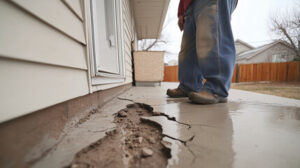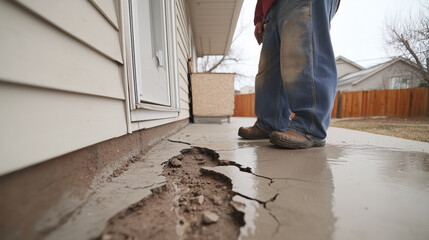Foundation repair now goes beyond simple cracks. It demands understanding the dynamic nature of soil. Different soil types react differently to moisture. This creates unique challenges for each site.
Expansive clay soils swell during wet seasons. During dry periods, they shrink and create voids. These movements stress concrete and framing. Cracks and misalignments follow as a result. Visit Website to learn more.
Foundations must now be assessed based on regional soil behavior. Instead of using one-size-fits-all fixes, modern methods adapt. Soil testing is key before any repair begins. It reveals the core reason behind structural shifts.
Subsurface mapping technology is transforming how repairs start. These scans detect hidden air pockets and shifts. Engineers can plan stabilization efforts more accurately. This reduces guesswork and future costs.
Stabilization foam is a new material gaining ground. It’s injected to fill voids beneath slabs quickly. The foam hardens while lifting the structure evenly. It’s clean, fast, and minimally invasive.
Some structures now use flexible foundation designs. These adjust slightly with soil movement. Instead of resisting the earth, they flow with it. It reduces stress on rigid points.
Hydraulic lift systems are evolving too. Controlled lifts now factor in long-term soil compression. These lifts are monitored digitally during repair. Engineers can adjust pressure with high precision.
Seasonal movement control is vital after repair. Landscaping and drainage play a role in soil moisture. Consistent moisture prevents expansion and shrinkage. This keeps the foundation balanced.
Air gaps under slabs lead to faster deterioration. Modern slab jacking involves polymer mixtures. These mixtures cure faster and last longer. They provide a lightweight yet powerful lift.
Root barriers are used to stop moisture-seeking plants. Deep roots disrupt foundation balance. Physical barriers guide roots away safely. This maintains both structure and greenery.
Moisture sensors are now being installed underground. These provide real-time updates on shifting hydration. Homeowners can adjust irrigation accordingly. It’s prevention rather than reaction.
Climate change alters the foundation care landscape. Increased rainfall or drought impacts foundation stability. Repair plans must account for extreme weather shifts. This ensures future resilience.
Tilt meters help track foundation angle changes. These give early warnings before damage worsens. Homeowners can act before major repair is needed. It’s like a smoke detector for the ground.
Micro-pile technology offers deep stability. Small-diameter piles reach down to stable earth. They distribute load through weak layers. This solution suits high-risk zones well.
Permeation grouting is being refined for targeted stabilization. This technique hardens surrounding soil in place. It’s useful in sandy or loose earth zones. The foundation then rests on stronger ground.
Not all cracks need intervention. Hairline cracks can result from drying concrete. Monitoring them over time is essential. Movement determines if repair is necessary.
Smart foundations are emerging in new builds. These use embedded sensors during construction. They track stress and movement for decades. Repairs become data-driven rather than reactive.
Repair techniques must respect building age. Older structures may not tolerate aggressive fixes. Historical materials need gentler approaches. Compatibility ensures structural harmony.
Some foundations now include integrated vapor barriers. These stop moisture from rising through slabs. This prevents mold and warping. It adds indoor air quality benefits too.
Curing methods influence concrete foundation strength. Rapid drying creates weak zones and fractures. Controlled humidity curing reduces risk. Long-term durability begins at the pour.
Lightweight structures require different support systems. Foundations can be thinner but wider. This spreads load evenly on soft soils. It reduces pressure buildup in one area.
Pest intrusion is often linked to foundation cracks. Termites and ants use gaps to enter homes. Sealing cracks also protects from infestation. It’s both structural and hygienic.
Inspections after earthquakes often reveal hidden faults. Foundation anchors may have shifted below. Specialized radar tools confirm alignment. Immediate repair prevents compound damage.
Overwatering nearby plants softens soil too much. This causes one side to sink faster. Balanced watering prevents imbalance formation. Lawn habits can affect house health.
Flood-prone areas require deeper foundations. These must reach past the water table. Special coatings protect against erosion. Drainage systems then redirect excess water safely.
Slab edge erosion is a silent threat. Water wears away exposed slab corners. This leads to uneven settlement. Gravel skirts or concrete borders reduce exposure.
Thermal expansion impacts foundation materials. Heat makes concrete swell slightly. Seasonal cycles cause repetitive stress. Expansion joints absorb this pressure over time.
Some repairs include wall anchor systems. These stabilize bowing basement walls. Anchors are installed deep into stable soil. Tension is applied slowly to straighten the wall.
Soil amendments can improve foundation performance. Mixing lime or cement into soil firms it up. This strengthens weak ground beneath. It makes future repairs less likely.
Foundation heave is the opposite of settling. Wet soil can push slabs upward. This causes buckling or uneven floors. Correct drainage reroutes water before it collects.
Hybrid foundation repairs combine multiple techniques. One part may need lifting while another stabilizes. This targeted approach ensures thorough correction. It avoids blanket methods that over-correct.
Interior signs of foundation issues include sticking doors. Uneven floors are another red flag. Trim separation and nail pops may appear. All hint at deeper structural movement.
The lifecycle of a repair includes monitoring. Initial fixes must be watched over months. Any new movement should be documented. Maintenance extends the repair’s life.
Some modern repairs are designed to be reversible. Temporary lifts or supports are used during construction. These are removed once balance is restored. This flexibility prevents overcorrection.
Access holes are made smaller now. This protects landscaping during repairs. Less damage means quicker recovery. It’s less disruptive for property owners.
Structural coatings now include fiber reinforcement. These fibers prevent crack propagation. They improve tensile strength in weak spots. It adds years to concrete surface life.
Some basements are redesigned after repairs. Walls are realigned and insulated. Interior waterproofing is added during reinforcement. It creates a more livable space.
Technology improves communication during repair. Drone imaging maps out exterior shifts. Clients receive 3D visuals before decisions. This transparency builds trust in the process.
Repairs in commercial spaces are time-sensitive. Downtime equals lost income. Rapid-set materials are used to reduce closure. Night shifts may be scheduled for minimal disruption.
Tree placement now factors in root patterns. Some trees send roots horizontally. These create long-term foundation risk. Strategic planting solves issues before they start.
Expansion soil tiles are a new concept. These absorb excess water under slabs. Then they slowly release it as needed. It balances soil shrink and swell naturally.
Retrofitting old foundations saves historic buildings. These projects require deep analysis first. Engineers reinforce without changing exterior look. It’s preservation through precision.
Soft story buildings are being reinforced globally. Their first-floor foundations need special care. Bracing systems distribute load properly. They prevent pancake collapse in earthquakes.
Post-tension foundations use steel cables. These cables compress concrete for extra strength. It resists cracking better than traditional slabs. They’re ideal for expansive soils.
Some repairs focus on waterproofing foundations from the inside. Crystalline sealants grow into cracks. They react with water to block further entry. It’s a molecular defense against leaks.
Cold climates demand frost-protected foundations. These use insulation under and around slabs. It stops frost heave from lifting structures. Heat loss is reduced too.
Foundation bolts are inspected during renovation. Rusted or loose bolts compromise stability. Replacing them strengthens the wall-floor connection. This is crucial in seismic zones.
Digital maintenance logs are becoming common. Each repair is documented and tracked. Homeowners keep history for future selling. It builds trust in the structure’s safety.
Vibration damage from nearby construction is monitored. Sensors track tremor impact on foundation. Temporary bracing may be added if needed. Prevention reduces costly aftermath.
Carbon fiber strips reinforce foundation walls from within. They’re thin but immensely strong. Once bonded, they stop walls from bulging further. It’s a non-invasive solution.
Pier-and-beam foundations have different needs. Beams must stay aligned and free of moisture. Crawlspaces need proper ventilation too. Moisture buildup rots wood quickly.
Underground water flow changes over time. Old drainage paths may no longer work. Updating these prevents new cracks. Foundation health relies on active water control.
Repairs must respect architectural design. Some homes can’t handle visible changes. Hidden reinforcements preserve style. It protects both structure and aesthetics.
Reinforcement bars inside concrete are tested for corrosion. Rust weakens internal strength. Early treatment stops expansion damage. It saves money down the road.

